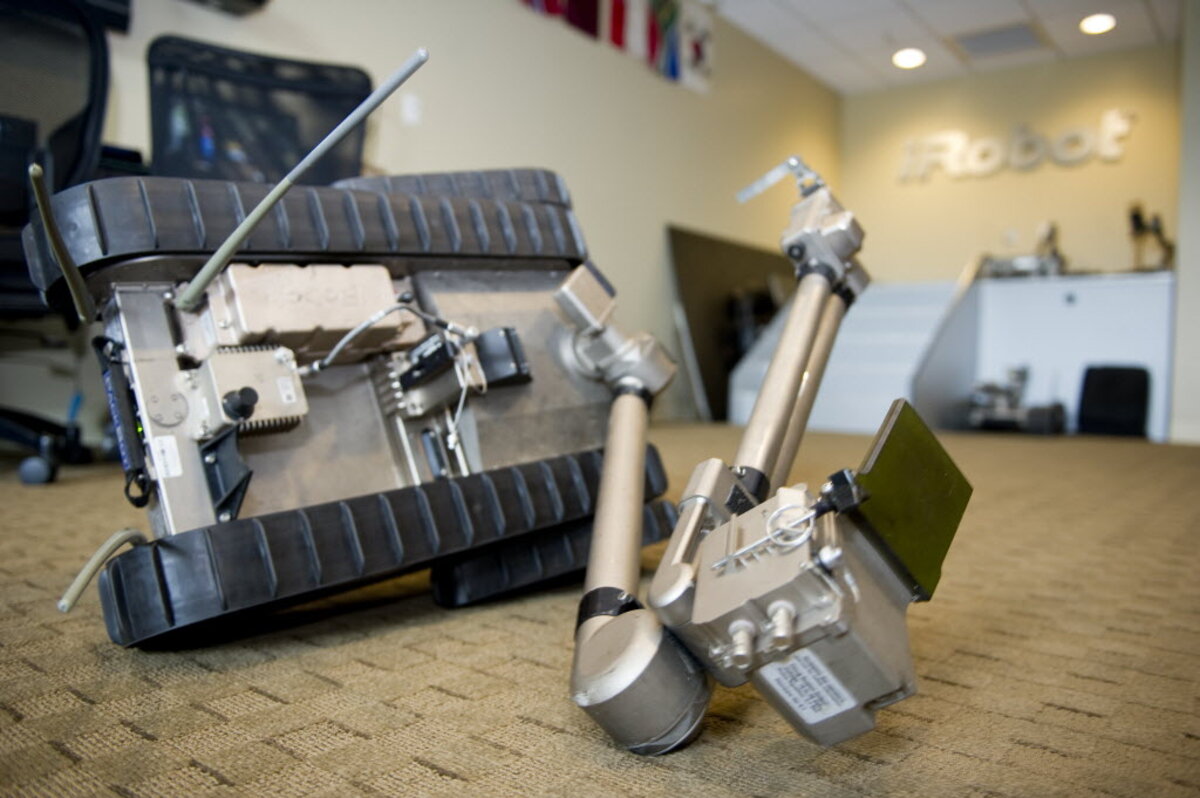For a fallen robot, a 21-gun salute
Loading...
They have served the United States in combat, and they have been lost in combat. They have been awarded Purple Hearts and memorialized with 21-gun salutes. They have been eulogized, mourned, and missed.
They are, of course, the US military’s robots.
American soldiers are becoming attached to their electronic comrades, – and that behavior reignites a question about how human attachment to robots might influence decisions on a battlefield.
In interviews with 23 Explosive Ordnance Disposal military personnel (one woman and 22 men), researcher Julie Carpenter found that soldiers reported unfettered willingness to send their robots into minefields – but also named their robots after wives and girlfriends and felt loss when those robots didn’t make it back to base. While not generalizable to the entire military, given the small sample size, Dr. Carpenter says that the results suggest that more research is needed on how robots and humans mix. That’s especially true as robots increasingly fill the US military’s ranks, and as the military develops new, more anthropomorphic robot designs, she says.
Carpenter’s research, which will be published on ProQuest as her PhD dissertation, is not the first scientific study about how soldiers feel about their robots.
In Afghanistan and Iraq, there have been large-scale deployments of battle robots such as TALON and Packbot, a small, portable robot with tractor treads and a video camera that can be used to survey a building for foes or detonate an improvised explosive device (IED). In 2007, the Washington Post reported that the robots scooting though booby-trapped cities, supplanting the humans that once had to do that job, were not going unappreciated – soldiers had , sometimes quite a bit. Ted Bogosh, then a master sergeant and a repairman for the Marines in Baghdad, told the Post that one soldier in his shop had became distraught when told that his robot, “Scooby Doo,” was not salvageable. The soldier would not accept a replacement robot.
The anecdote was also repeated in a 2009 , a defense analyst at the Brookings Institution and the author of "Wired for War: The Robotics Revolution and Conflict in the 21st Century."
In the latest research, the interviewed soldiers said that they had no qualms about sending their robots onto the battlefield. But there was a potential hitch: the soldiers often named their robots after a girlfriend or wife. One soldier told Carpenter that his robot, riding along with him in his jeep and resting next to him as he slept really did feel a bit like his girlfriend, Carpenter says. None of the robots were named after ex-girlfriends, Carpenter says.
And some soldiers saw the robots as an extension of themselves or of the soldier manning it. Soldiers said that they could tell who was behind the robot’s remote based just on how the robot was moving, Carpenter says.
“They’re very aware that the robot is a tool and that it’s not alive,” says Carpenter. “But there is this ambiguity in how they interact with the robot.”
“They go back and forth between calling it human-like, or animal-like, or simply a tool,” she said.
Following Carpenter’s research, first reported on the University of Washington webpage last week, military personnel to share war stories of robots saved and robots lost.
In one shared tale, a soldier’s TALON robot slipped through a guardrail on a bridge over the Tigris River in Iraq. As it dangled from its chord above the water, the team sent its “little Packbot,” Danny DeVito, to rescue it. The TALON was pulled up and, since the robot's bridge jump happened around the time that the actor Owen Wilson reportedly attempted suicide (in 2007), the TALON was dubbed Owen Wilson.
“My Team Member also took him to mental health to get him checked out and hit on the gorgeous E-4 that worked over there,” said the soldier.
Another user said that his or her team in Taji, Iraq (near Baghdad), had sent off a ruined robot with a 21-salute funeral and a Purple Heart. Robots, the user said, “can develop a personality, and they save so many lives.” Meanwhile, another commentator mourned the loss of “Boomer,” so named because “he” scouted bombs. “Boomer” was also destroyed in Iraq, taken “from this world far too early,” the commentator said.
That soldiers do care for their robots suggests that soldiers might make unconscious decisions on the battlefield on the basis of those feelings, Carpenter says. For example, if a soldier calls a robot after his wife, will he or she be willing to sacrifice just as much to save it as he or she would to save a spouse?
And that’s all the more possible as robots get anthropomorphic or animalistic makeovers, she says. Arguably, the military’s current robots don't necessarily invite warm, fuzzy feelings. Packbots, of which there are some 2,000 on tour in Iraq and Afghanistan, look like a miniature tank, but with a long, camera-topped neck. If this bot resembles an animal, it’s an Apatosaurus.
But most prototypes for future combat robots do resemble humans or animals, as robotics researchers plumb our – and our pet’s – physiologies for inspiration: Boston Dynamic’s LS3 robot, designed for the Marines, prances like a charmingly fat cat, and its BigDog robot moves, well, like man’s best friend.
At the same time, the company’s prototypes are also striding into humanoid terrain. The Atlas robot resembles a robot as cinema has always imagined it – a metal, broad-shouldered human. And the goes a step further: It can be suited up to handle chemical warfare, and “simulates human physiology within the protective suit by controlling temperature, humidity and sweating.”
“It very much resembles a human,” says Carpenter, of PETMAN. “And it’s important to understand how people are interacting with robots right now, before they look anything like a human.”





